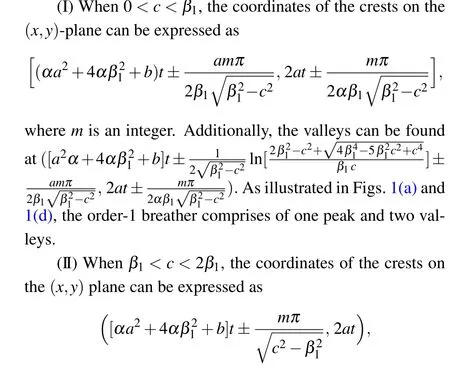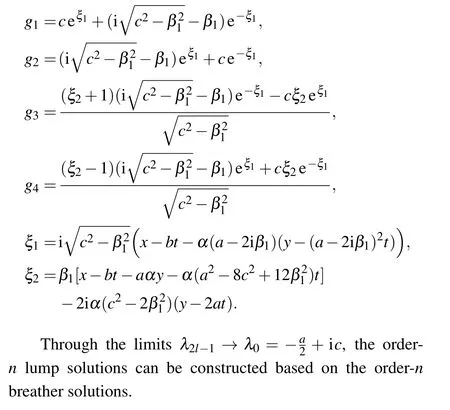From breather solutions to lump solutions:A construction method for the Zakharov equation
2023-12-15FengYuan袁丰BehzadGhanbariYongshuaiZhang张永帅andAbdulMajidWazwaz
Feng Yuan(袁丰), Behzad Ghanbari, Yongshuai Zhang(张永帅), and Abdul Majid Wazwaz
1College of Science,Nanjing University of Posts and Telecommunications,Nanjing 210023,China
2Department of Mathematics,Kermanshah University of Technology,Kermanshah,Iran
3Department of Mathematics,Shaoxing University,Shaoxing 312000,China
4Department of Mathematics,Saint Xavier University,Chicago,IL 60655,USA
Keywords: Zakharov equation,breather solution,b-positon solution,lump solution
1.Introduction
As an important branch of the nonlinear science,the theory of integrable systems has been widely applied to various fields, including mathematics, physics, biology, oceanography,etc.The studies of integrable systems focus on the development of analytical models that have dipicted plenty of natural phenomena as well as precise analyses of complex nonlinear partial differential equations(NPDEs).
For a typical integrable system,the nonlinear Schr¨odinger(NLS)equation reads
which originates from the physics of nonlinear dispersion mediums with a cubic-form nonlinearity term.[1,2]
The NLS equation has been proven to be a fully integrable nonlinear system,which makes it a useful model in many technological applications.For example,it provides guidelines for the generation of solitons in planar waveguides in self-trapped beams[3]and in nonlinear fibers.[4]Theoretically,fruitful analytical solutions of the NLS equation have been proposed.[5-9]
The general statement on nonlinear equations can provide strong theoretical support to our physical and experimental findings.Among all the promotion methodologies, an appropriate one would be multiplying the dimensions of the integrable system.Introducing additional variables is a technique that can increase the spatial dimension of a nonlinear equation without compromising the integrability of the original equation.This is a crucial aspect of research,as it allows for more complex models to be analyzed while retaining the integrability property of the equation.So far, the NLS equation has extended itself to 2+1 dimensions by several means.
Firstly proposed by Davey and Stewartson in 1974,[10]the Davey-Stewartson(DS)equation is an important(2+1)-dimensional generalization of the NLS equation,namely,
whereAandQdenote complex and real functions, respectively.The DS equation finds extensive applications in various fields including plasma physics,[11]nonlinear optics,[12]and fluid mechanics.[13]Regarding the analytical solutions of this equation, rogue waves, lump solutions, and hybrid solutions that combine lumps and solitons have been constructed.[14-19]
As another (2+1)-dimensions generalization, the Zakharov equation is the main topic of this study,that is,[20]
whereq(x,y,t)is a complex function andVis a real function.It should be noticed that the Zakharov equation becomes the NLS equation if∂x=∂y.Constructed firstly by Zakharov in 1980,[20]the Zakharov equation has been widely studied due to its physical background.This equation was later re-derived by Strachan from symmetry space-based integrable systems and through the reduction in terms of dimensions on the selfdual Yang-Mills equation.[21,22]
The Lax pair, Darboux transformation, and Hirota bilinear forms of the Zakharov equation have been presented in Refs.[22-24].In Ref.[25],the authors studied its geometrical and gauge equivalent counterparts,and in Ref.[26]Velan and Lakshmanan investigated the infinite-dimensional Lie algebras of(3)Lie symmetries.Plenty of analytical solutions have also been discovered,including various solitons,[27-30]Jacobi elliptic function solutions,[31]and line rogue waves.[32-36]In Ref.[37] Radha and Lakshmanan generated a new class of“induced localized structures”by the line soliton’s interaction with a curved soliton.
Despite extensive research on the exact solutions of the Zakharov equation, the spatially periodic solutions, including breather solutions, b-position solutions, and lump solutions, have not been well studied.Lumps are 2D soliton solutions that are weakly localized and decay algebraically in all directions.[38-46]They are a type of rational function solutions that are frequently observed in high-dimensional systems.The investigation and examination of lump solutions in high-dimensional systems is an interesting area of research.[43-47]
The primary target of this study is to obtain lump solutions from the breather and b-positon solutions of Eq.(3)whenε= 1.The fundamental method we use is the Darboux transformation.Previous studies have shown that multibreather solutions associated with the NLS equation can result in higher-order rational solutions.[9]Correspondingly, there remain two main questions:
1.Does an explicit lump solution exist for the Zakharov equation?
2.How can we explain the origins of these solutions?
To obtain the lump solutions of the Zakharov equation,we propose a two-stage eigenvalue degradation process for the multi-breather solutions.In order to carry out this double degradation process on the Lax pair eigenvalue, the bposition solution of the Zakharov equation is first constructed,which can be obtained from the breather solution of the limitλ2l-1→λ1.[48-50]
The rest of this paper is organized as follows.In Section 2 we introduce the determinant representation of DT to rephrase then-soliton solution of the Zakharov equation.In Section 3,the derivation ofn-order breather solutions is demonstrated and the general forms of b-positon solution and lump are presented.Moreover, we investigate the double degradation of eigenvalues.In Section 4,we present our conclusion remarks.
2.The n-solutions

3.The breather,b-positon,and lump solutions
By solving Eq.(5) using the initial plane wave seedq=ceiρ(wherea,b, andcare real constants andρ=ax+by-abt,a,b,c),one can derive a total ofnsets of eigenvalues and their corresponding eigenfunctions as follows:

The coordinates of crests and valleys can be obtained by solving∂|q[1]|/∂x=0 and∂|q[1]|/∂y=0.Depending on the selected parameters,three different scenarios can be observed.

Fig.1.Behavior offor a=1/2,b=1,c=1,t=0: (a)α =1/3,β1=8/7,(b)α =1/3,β1=7/8,(c)α =2,β1=2/5.(a)-(c)Threedimensional profiles.(d)-(f)Their corresponding density profiles.The black points are the position of the crests,and the yellow points are the position of the valleys.

wheremis an integer.Additionally, the valleys can be found at
Figures 1(b) and 1(e) display the one peak and two valleys present in each unit of the order-1 breather.
(III) Whenc≥2β1, the coordinates of the crests on the(x,y)plane can be expressed as
wheremis an integer.Additionally, the valleys can be found at


where[]means taking the integer part.D2nandW2nare given in Eq.(6)andψjkare given in Eq.(7).

Fig.2.Density ofwith a=1/2,b=1,c=1,α =1,β1=4/5: (a)t=0,(b)t=5,(c)t=15,(d)t=50.

Fig.3.Density ofwith a=0,b=1/2,c=2/3,α =1,β1=4/5: (a)t=0,(b)t=1,(c)t=5,(d)t=25,(e)t=80.
Finding an order-1 b-positon,simply a single breather,is trivial.The next nontrivial solution is an order-2 b-positon with a phase difference between the trajectories of the highorder b-positon and the order-1 breather solution, similar to Refs.[9,49,50].An order-nb-positon exhibitsnparallel breathers of the same shape,making its dynamics comparable to the interaction between order-nbreathers.In this context,we focus on the order-2 case.To obtain the order-2 b-positon solution,we setn=2 in Eq.(9).Figures 2 and 3 depict the dynamics of the order-2 b-positon solution with varying parameters.Ifc>β1,the interaction between two units of the order-2 b-positon is perpetual, as illustrated in Fig.2.Conversely, ifc<β1, the interaction between two breathers is strongest att=0 and gradually diminishes over time.Fort →∞,the order-2 b-positon displays two parallel breathers of the same shape,as shown in Fig.3.The first nontrivial degenerate breather is the order-2 degenerate breather,which is given as follows:



Fig.4.Characteristics ofwith a=1,b=1,c=1,α=-1:(a)3D profile,(b)the corresponding density,(c)the contour curves at t=0,t=1,t=2.The black points are the position of the crests and peaks.

Fig.5.Density of|with a=1/2,b=1/2,c=2/3,α =1: (a)t=0,(b)t=-10,(c)t=-1,(d)t=0,(e)t=10,
Theorem 2 The order-nlump solution for the Zakharov equation is



Fig.6.Density with a=2/3,b=3/4,c=1,α =1/6,t=0: (a)2 for β1=4/5,β2=7/8,(b)|]|2 for β1=4/5,β2=39/46,(c)2 for β1=4/5,β2=19/23,(d)||2 for β1=4/5,β2=801/1000,(e)||2 for β1=4/5.

Fig.7.Density profiles with a=2/3,b=3/4,c=1,α=1/6,t=0: (a)2 for β1=49/50,(b)|q for β1=199/200,(c)||2 for β1=799/800,(d)-(f)||2 for β1=799/800.

Fig.8.(a)Sectional view of|at y=0 with a=2/3,b=3/4,c=1,α =1/6, β1 =799/800, t =0.(b) Sectional view of || at y=0 with a=2/3,b=3/4,c=1,α =1/6,t=0.
4.Conclusions
We have systematically provided the order-nbreather solutions for the Zakharov equation using the determinant representation of the Darboux transformation described by Eqs.(6)and(7).The formula for the order-1 breather solution is given in Eq.(8),with detailed discussions on the parameter selection ofcandβkin three cases.Additionally, we introduce a new type of periodic solution called the b-positon solution, which is obtained by taking the limitλ2l-1→λ1of the eigenvalues of the Lax pair.This solution is generated from a plane wave seed solution using ann-fold Darboux transformation generated from the order-nbreather solution.A formula for the bpositon solution is derived in Eq.(9),utilizing the determinant representation of the higher-order Taylor expansion and the Darboux transformation.Furthermore, the order-nb-positon solution can be transformed into an order-nlump solution via the limiting process onλ1→λ0,whereλ0refers to a particular eigenvalue associated with the Lax pair eigenfunctionψof the Zakharov equation.The formula for the order-1 lump solution is given in Eq.(12), and this study includes the evolutions of the order-1 and order-2 lump solutions over time, as shown in Figs.4 and 5, respectively.Also we use the derived analytics to illustrate the transition dynamics from the breather to the b-positon solution at an order-2 basis in Fig.6.This is followed by the transition of the b-positon solution to the lump solution at order-2 basis, as depicted in Fig.7.In conclusion,this study systematically presents a generation mechanism for higher-order lump solutions of the Zakharov equation from a degeneration process of the dual eigenvalue regarding multi-breather solutions.Our analytical results show the effective mechanism of generating lump solutions of the Zakharov equation from the double eigenvalue degeneration process of breather solutions.
Acknowledgments
This work is sponsored by NUPTSF (Grant Nos.NY220161 and NY222169), the Foundation of Jiangsu Provincial Double-Innovation Doctor Program(Grant No.JSSCBS20210541), the Natural Science Foundation of the Higher Education Institutions of Jiangsu Province (Grant No.22KJB110004), and the National Natural Science Foundation of China(Grant No.12171433).
杂志排行
Chinese Physics B的其它文章
- Diamond growth in a high temperature and high pressure Fe-Ni-C-Si system: Effect of synthesis pressure
- Multi-channel generation of vortex beams with controllable polarization states and orbital angular momentum
- Calibration of quantitative rescattering model for simulating vortex high-order harmonic generation driven by Laguerre-Gaussian beam with nonzero orbital angular momentum
- Materials and device engineering to achieve high-performance quantum dots light emitting diodes for display applications
- Complete population transfer between next-adjacent energy levels of a transmon qudit
- Ultralow-temperature heat transport study of noncentrosymmetric superconductor CaPtAs
